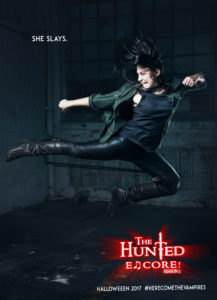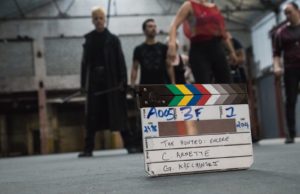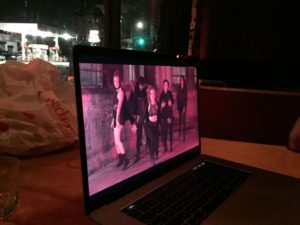 This Halloween, October 31st, 2017, the original web series, The Hunted: Encore by Charging Moose Media, returns for a second season of musical mockumentary vampire slaying adventures. Straddling both genres and styles, the series’ do-it-yourself spirit shines in the best way possible, offering a truly original take on the well-loved slayer vs. vampire trope.
This Halloween, October 31st, 2017, the original web series, The Hunted: Encore by Charging Moose Media, returns for a second season of musical mockumentary vampire slaying adventures. Straddling both genres and styles, the series’ do-it-yourself spirit shines in the best way possible, offering a truly original take on the well-loved slayer vs. vampire trope.
This musical version of the longest running web series to date is just one of the affiliates within the network that grew from creator Robert Chapin’s original The Hunted series. Chapin began the project to give his stage combat students an outlet to make practical use of their fighting skills, but as technology evolved, it flourished into a wide social network of creatives collaborating to find new, unique ways to tell the story of vampire slayers attempting to prove the existence of vampires.
The Hunted: Encore grew out of The Hunted: Expulsion, featuring Ned Donovan, whose musical theater background peaked Chapin’s interest. “I believe in creating jobs and giving people opportunities to utilize their talents, so when I heard Ned had this musical theater background, I thought it would be great to bring that skillset to the show,” noted Chapin.
 Director Crystal Arnette continues to implement the show’s signature mockumentary style with the help of cinematographer Garrett Kafchinski, who harnesses the skill of rack focusing to evoke the show’s supernatural theme. “I joined the team four days before principal photography, so everything went really quickly for me. We filmed four days total, three days in July and one pick-up day in August,” Arnette relayed. Although Arnette was not around for pre-production, the show’s fast pace was made possible due to the team’s close collaboration and further aided by music supervisor, Marcus Bagala.
Director Crystal Arnette continues to implement the show’s signature mockumentary style with the help of cinematographer Garrett Kafchinski, who harnesses the skill of rack focusing to evoke the show’s supernatural theme. “I joined the team four days before principal photography, so everything went really quickly for me. We filmed four days total, three days in July and one pick-up day in August,” Arnette relayed. Although Arnette was not around for pre-production, the show’s fast pace was made possible due to the team’s close collaboration and further aided by music supervisor, Marcus Bagala.
“This season we really focused on making things cohesive. In the first season, the musical style catered to the characters, 1980s inspired rock for the vampires who were sired in the 80s, and more youthful 2000s pop punk style for the younger slayers. This season is more stylized and grander in many ways to match Crystal’s style of directing,” Bagala revealed.
 Arnette and Bagala collaborated closely throughout shooting and post-production to streamline timing to create the music video quality production Arnette sought to add to the show. “We try our best not to rely on post production,” Arnette confessed. This philosophy extends throughout multiple departments. Chapin, a special effects designer by day, seeks to limit the amount of digital effects used, favoring the use of practical effects, so he can create the digital effects himself: a job that more often takes ten craftpeople in professional movie and television production.
Arnette and Bagala collaborated closely throughout shooting and post-production to streamline timing to create the music video quality production Arnette sought to add to the show. “We try our best not to rely on post production,” Arnette confessed. This philosophy extends throughout multiple departments. Chapin, a special effects designer by day, seeks to limit the amount of digital effects used, favoring the use of practical effects, so he can create the digital effects himself: a job that more often takes ten craftpeople in professional movie and television production.
The diverse team of creative individuals working on The Hunted: Encore bring a truly original and raw flavor to the second season, which heralds girl power and epic music in action, literally. Crystal Arnette is one of the few women who currently direct a production in the action genre, and she hopes she won’t be the only one when she goes to film festivals for her film in the future.
In the end, the series and the environment surrounding the production is about family, and finding the path you were meant to pursue, enjoying every challenge along the way.
To view the show, link to:
http://www.thehuntedencore.com.





